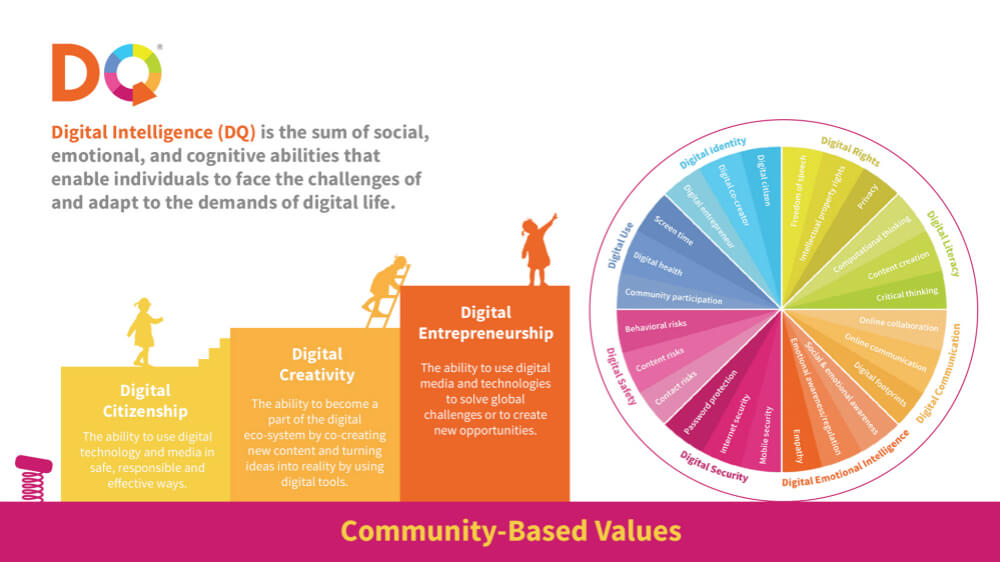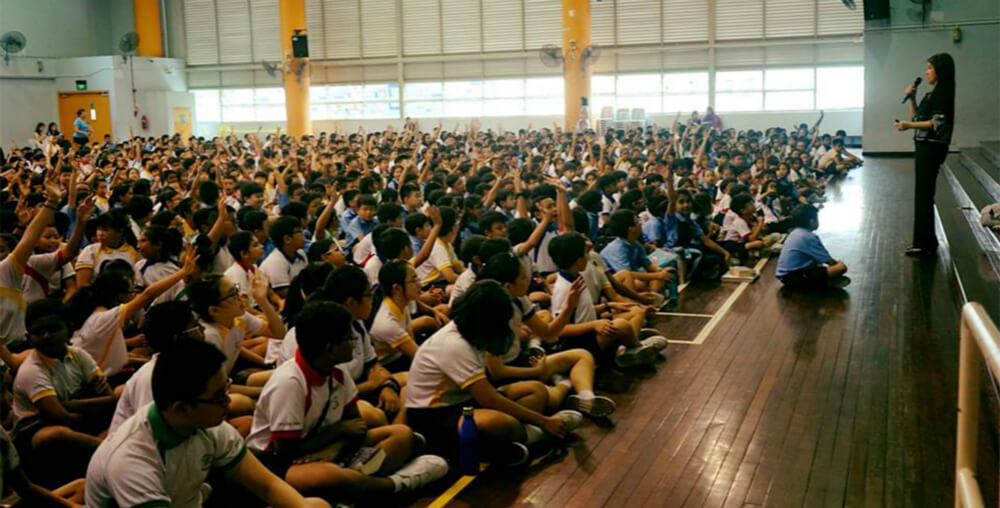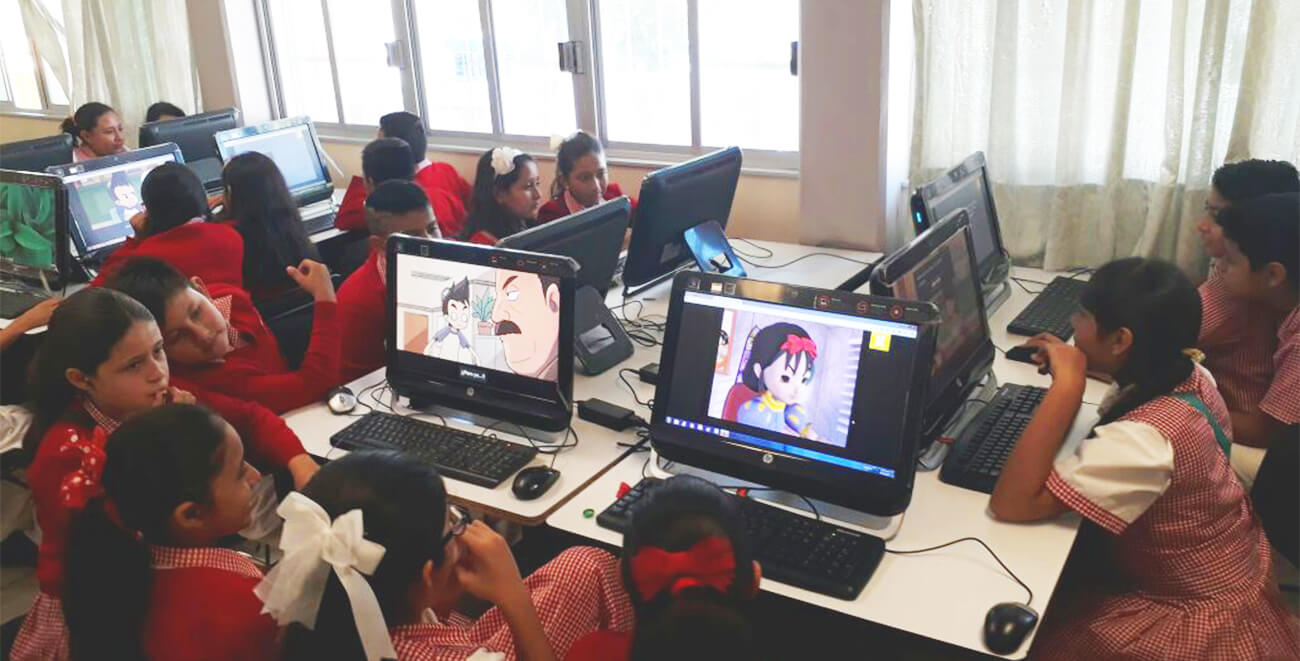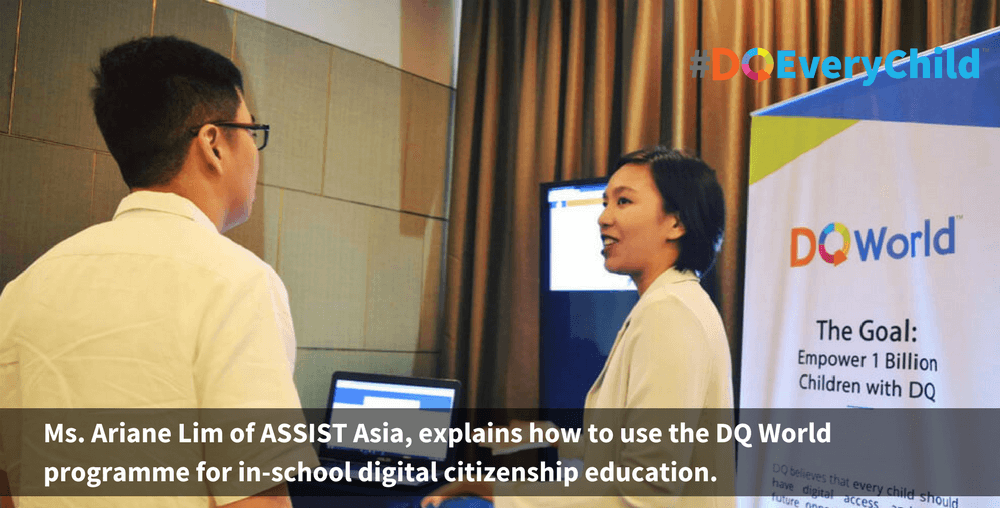| Executive Summary
“Is technology good or bad for our children?” |
|
| This question has been nagging parents. Recent controversies about the Apple iPhone’s harmful effects on children1 and the French government’s new decision to ban smartphones2 from schools have sparked a global debate on the impact of digital media and technology on children.
In fact, this question may be the wrong question to ask. Technology has already become indispensable in our children’s daily life. Being able to access the digital world is one of their basic rights of the 21st century. Instead of being crippled by the dilemma posed by the above question, we should be inspired by the potential upside of technology in children’s lives. So a more important question to ask is |
|
|
“Are our children equipped with digital skills to |
|
|
The 2018 DQ Impact Report (the Report) addresses this question. It examines the precarious status of children’s exposure to cyber-risks worldwide, and seeks to understand how children become exposed to cyber-risks and how these risks affect children. The Report focuses on children who are 8-12 year olds as this age group is when children start actively using digital media and devices while forming digital habits with long-lasting effects on their sense of identity, future behaviours, and relationships. |
|
More importantly, the Report discusses how we, as nations, have a collective responsibility to build an “ethical digital ecosystem” in which every child has basic protections, rights, and equal opportunities to thrive in their digital future by working together with all stakeholders – including parents, teachers, communities, ICT companies and governments. It suggests practical solutions for empowering our children with digital skills to mitigate risks and maximise opportunities using #DQEveryChild.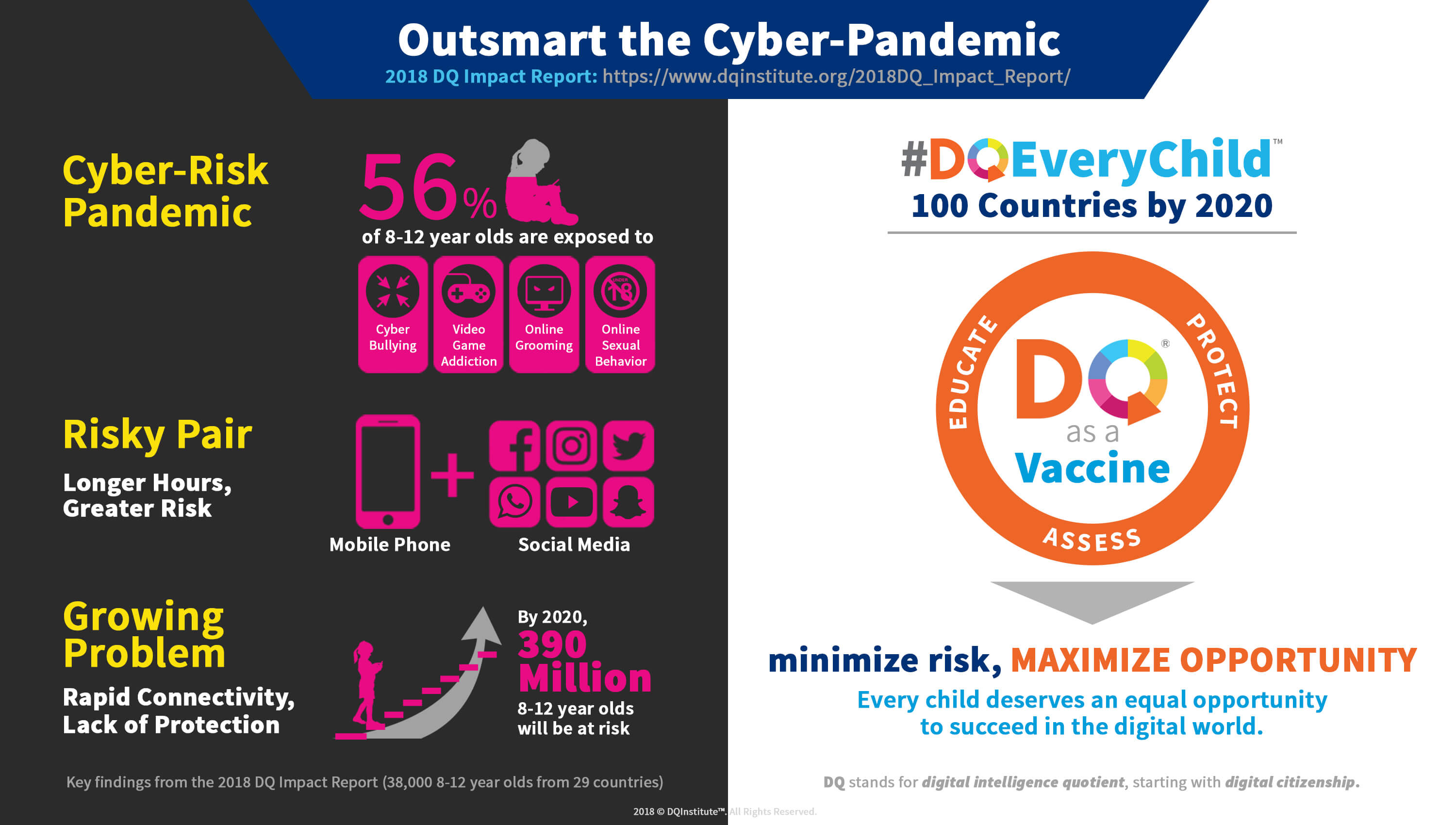 |
|
The Report consists of the following sections:
| |
The Challenge
| Cyber-Risk Pandemic
The 2017 DQ Impact Study (the Study) revealed that 56% of 8-12 year old study participants across 29 countries are involved in at least one of these major cyber-risks: cyberbullying, video game addiction, offline meetings, and online sexual behaviours. This amount of risk is tantamount to saying that our children are in the middle of a cyber-risk pandemic. |
|
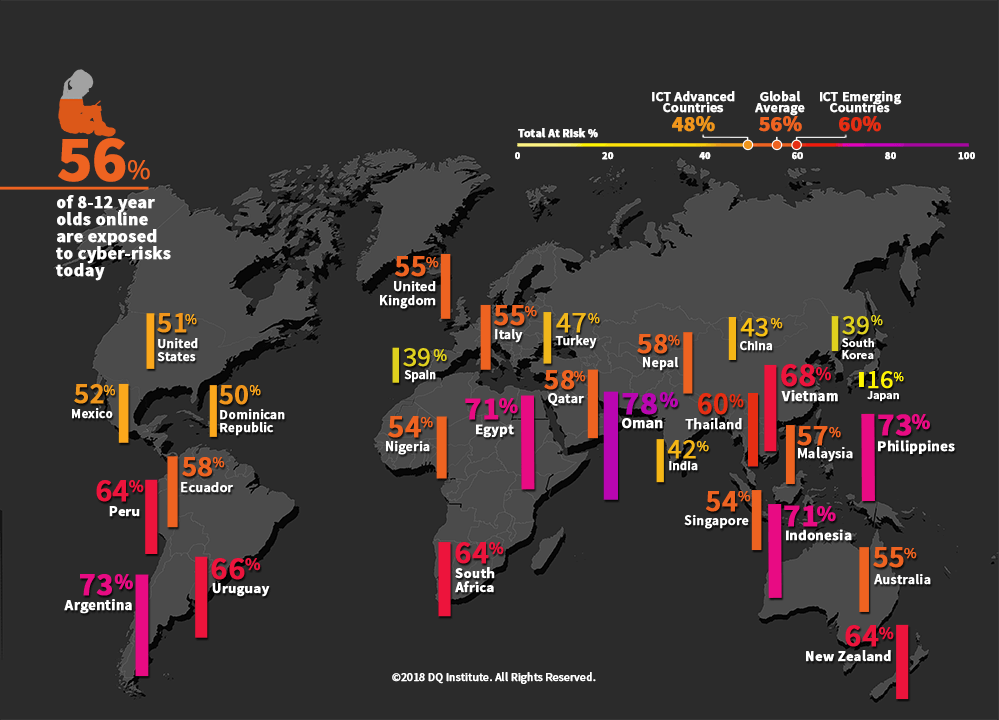
|
|
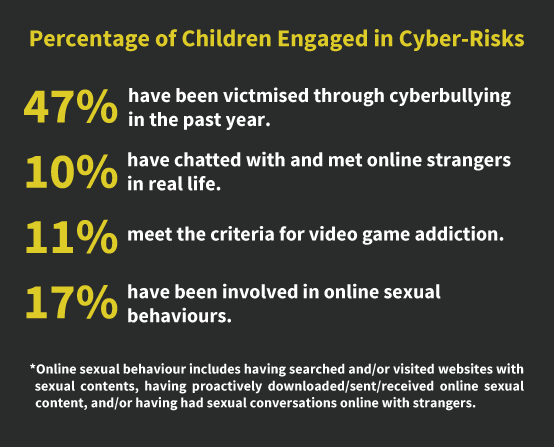 |
|
| Having been exposed to these cyber-risks does not directly indicate that children have received permanent physical or mental harm. However, continuous exposure to these risks at an early age poses a danger to overall development, well-being, relationships, and future opportunities for children.
We need to pay attention to consistently high cyber-risk prevalence across countries. The cyber-risk pandemic tells us that it is not an issue of some individuals in some countries, but a global and generational issue. The current state of technology has not been developed with placing children at its core. This cyber-risk pandemic reflects how current technology does not uphold the core principles of the United Nations Convention on the Rights of the Child (UNCRC). Today, the following cyber-risks gravely affect children worldwide: digital misinformation (violation of Article 17 – access relevant information and media), cyberbullying (violation of Article 19 – protection from all forms of violence), online grooming (violation of Article 11 – kidnapping), technology addiction (violation of Articles 19, 31 – the right to relax and play), privacy invasion and hacking (Articles 8, 16 – the right to privacy and preservation of identity), exposure to violent and inappropriate contents/contacts (Article 17, 19, 34 – the right against sexual exploitation) and online radicalisation and trafficking (Article 35 – the right against abduction and trafficking). |
|
 |
“I think the Philippines is one of the most targeted countries for human trafficking, sexual exploitation through online, and that’s why it’s very important to safeguard our children from these digital threats” – Ms Ariane Lim, Project Consultant at Assist Asia, the Philippines |
| Articles 3 (best interests of the child), 4 (protection of rights) and 6 (survival and healthy development) clearly state that every measure must be taken to ensure the respect, protection, and fulfilment of children’s rights by governments and all other stakeholders.
Thus, there is an urgent call for us as a global community to work together to put our children first and to reshape the digital ecosystem. |
|
ICT Emerging
Country Dilemma
Where is the cyber-risk pandemic growing exponentially, and why?
| Another worrisome fact about this cyber-risk pandemic is its uneven prevalence across countries. It attacks more heavily in Information and Communication Technology (ICT) emerging countries when compared to ICT advanced countries. The Study revealed that children from ICT emerging countries are 1.3 times more likely to be involved with cyber-risks compared to those from ICT advanced countries on average (60% vs. 47%). Particularly, cyberbullying (50% vs. 37%) and video game addiction (12% vs. 8%) are significantly more prevalent in ICT emerging countries compared to ICT advanced countries.
What is more worrying is that in ICT emerging countries, there is a significantly positive linear trend between mobile broadband subscription and children’s exposure to cyber-risks. However, such a troubling association was not seen in ICT advanced countries. While ICT advanced countries have more experience and built-in social infrastructures to deal with cyber challenges, such as enhanced public awareness about cyber-risks and online protection policies and practices, ICT emerging countries leapfrog into mobile technology directly without enough awareness nor preparation to protect children from cyber-risks. |
|
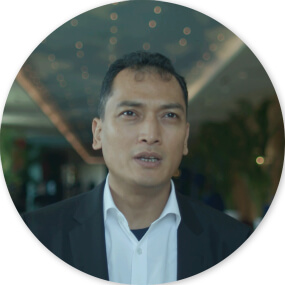 |
“If you look at Myanmar in 2013, 6% of the population had a mobile phone. And then we opened up the telecom industry in 2013. Within 18 months, 65% of the people had Internet through mobile devices. And now we have more than 85%… Myanmar people do not know what the Internet is, they only know Facebook. There is such low awareness of online challenges and risks that children can have from these platforms.”
– Mr. Ken Tun, CEO of Parami Energy, Myanmar |
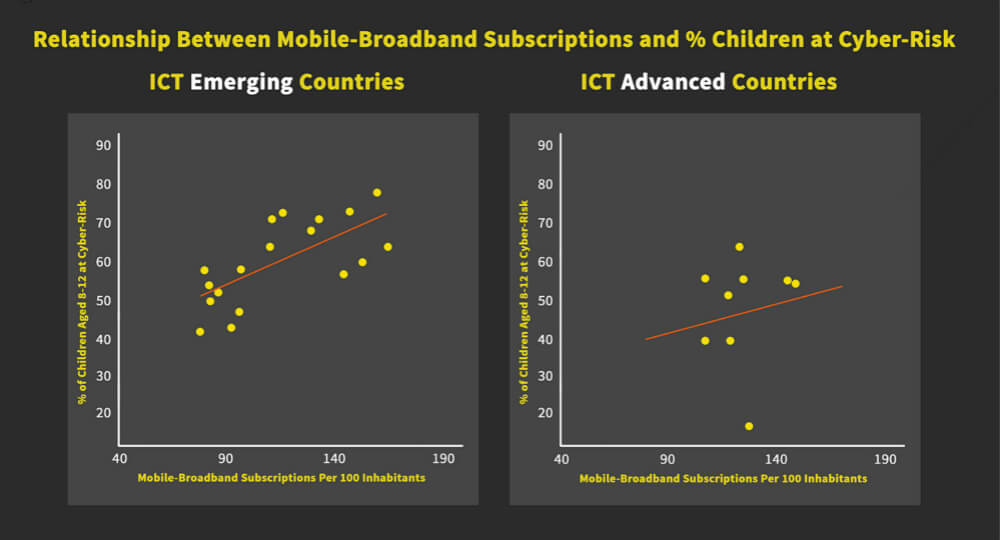 |
|
| These results require systematic effort and intervention at the global level to support ICT emerging countries in protecting children from cyber-risks. Given the inherently slower nature of the education and government sectors compared to technology, it can be difficult for nations to effectively institute such measures by themselves within a short period of time. | |
| With rapid increases in Internet penetration in ICT emerging countries, it is estimated that over 720 million 8-12 year olds will be online by 2020, with more than 90% of these users from ICT emerging countries. Without immediate support from the global community, more connectivity will most likely translate into more risks facing children in these countries and the impact of cyber-risks will continue to grow. Currently, 260 million children globally are estimated to be involved with cyber-risks and the number is predicted to rise to 390 million by 2020. | |
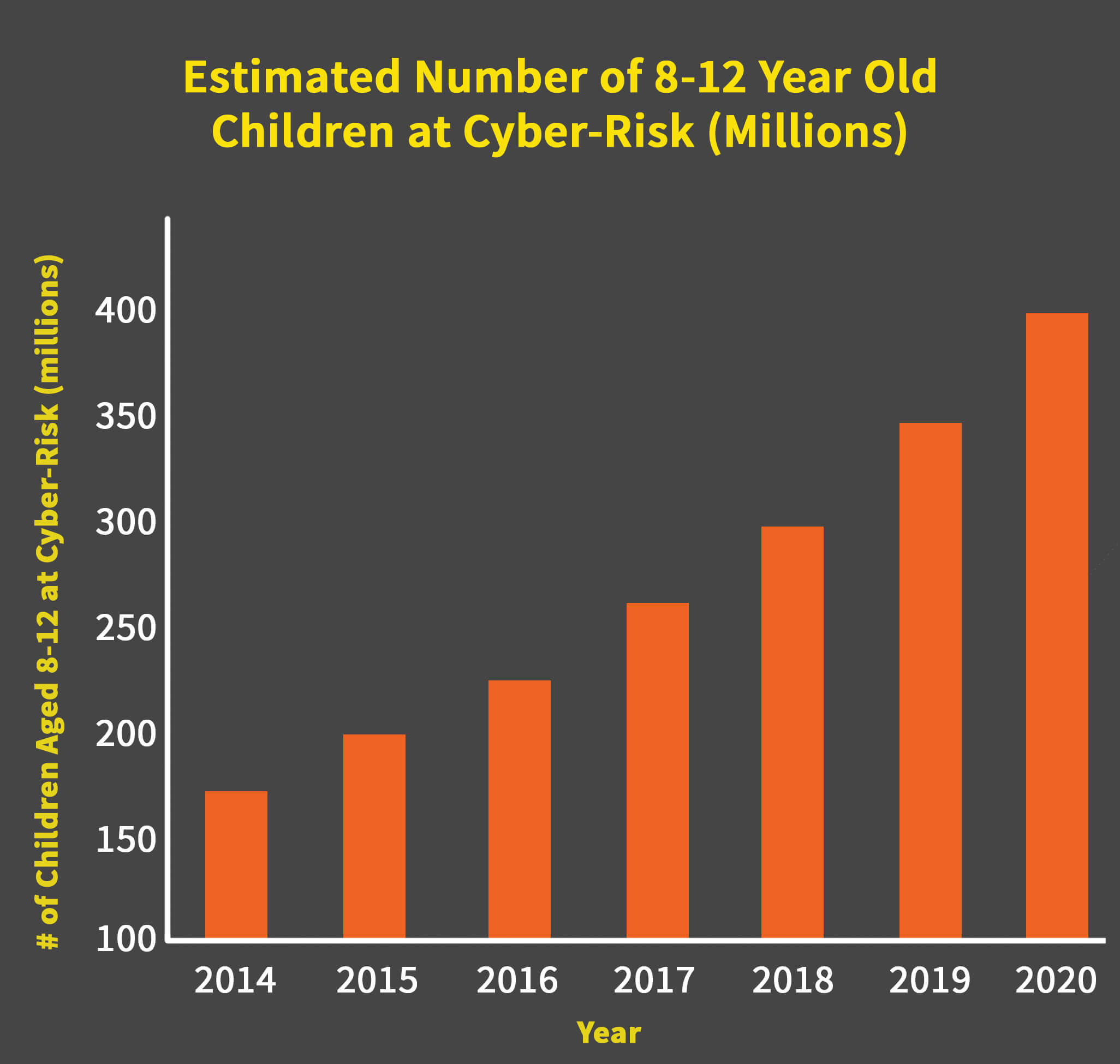 |
|
| The Study found that children excessively use digital media through mobile phones and other Internet-connected devices from an early age. Combined with their inherent developmental stage of limited capability for self-regulation, susceptibility to peer pressure, and lack of digital citizenship skills, they are exceedingly exposed to various cyber-risks11,12. This is especially the case when children own mobile phones and actively engage in social media. In such cases, they have a 70% likelihood to be exposed to at least one cyber-risk including cyberbullying, video game addiction, offline meetings and online sexual behaviours. | |
|
|
|
1. Global Average of 32 Hours of Screen Time for Entertainment Use Alone
The Study showed that 8-12 year olds spend an average of 32 hours per week in front of digital screens for entertainment alone globally. This is longer than the time children spend in school. These days, it is not uncommon for children to be required to use the Internet for their schoolwork. In the Study, we focused on screen time for entertainment only: asking children about the amount of time they used their devices for watching TV shows and videos, playing video games, and using social media sites or apps. Thus, the total screen time increases even more when factoring in screen time for homework assignments. Even though the American Academy of Pediatrics7Â changed their screen time guidelines for children to accommodate more time due to the ubiquitous nature of screens today, it is still important to remember that their original guideline was less than two hours per day for this age group. Worldwide, children are currently spending a considerably excessive amount of time online. While there is as of yet no consensus on a “safe” amount of screen time, numerous studies suggest significant positive correlations between excessive screen time and exposure to various cyber-risks and various developmental issues, such as obesity, sleep disorders and attention problems8. The Study also confirmed the highly statistically significant positive association between screen time and exposure to all four major cyber-risk categories among 8-12 year olds. |
|
 |
|
|
2. 50% of 8-12 Year Olds Access the Internet through Their Own Mobile Phone
Globally, the number one device for 8-12 year old children to access the Internet is a personal mobile phone, followed by a family PC. 50% of participants own a personal mobile phone and access the Internet through the phone. A majority of them (60%) get their first phone by the time they reach 10 years old. When children own personal mobile phones, they start to get unlimited access to the digital world at any time and almost anywhere. Even young adults are accustomed to continue checking their mobile phones, and even a single day without access can be anxiety producing9. It is difficult to expect 8-12 year olds to be able to handle their mobile phones with discipline. Moreover, children in ICT advanced countries tend to go online in a more protected digital environment – one that is supported by teachers and parents – compared to those in ICT developing countries. Whereas children in ICT advanced countries tend to use more family devices and school computers to connect to the Internet, children in ICT emerging countries tend to do so through personal mobile phones and Internet cafes. The result is that children in ICT emerging countries may receive less support from trusted adults while navigating the online world. |
|
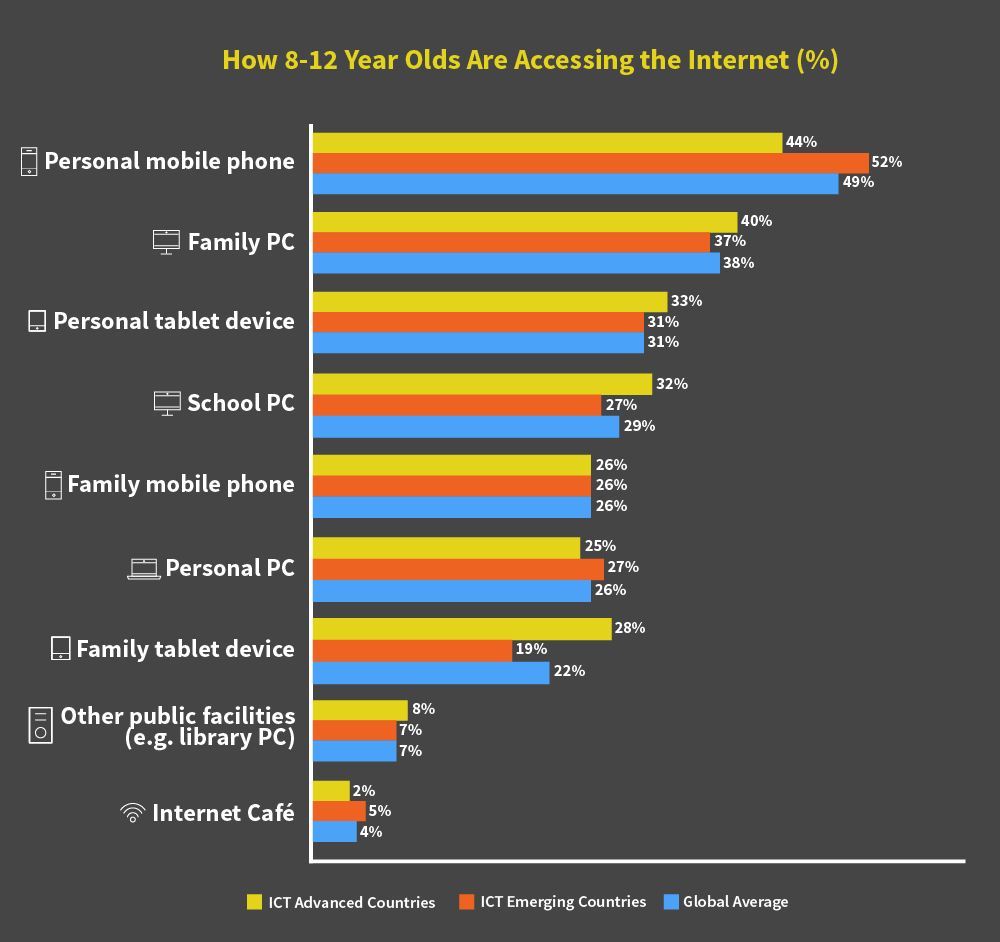 |
|
|
3. 85% of 8-12 Year Olds Use Social Media
On average, around 85% of 8-12 year olds worldwide actively use social media sites or apps even though the legal age they can officially start using most social media applications is 13 years old. The #1 online activity of children globally is watching videos (72%) and listening to music (51%), followed by searching (51%), playing video games (49%), and chatting (38%). Thus, with no surprise, the most popular site for this age group is YouTube. More than half of children use YouTube. The next top four popular platforms for children were WhatsApp (45%), Facebook (28%), Instagram (27%) and Snapchat (23%). Children in ICT emerging countries are more significant users of social media then those in ICT advanced countries (90% vs. 81%). In particular, Facebook and Twitter are significantly more popular among children in ICT emerging countries compared to ICT advanced countries. |
|
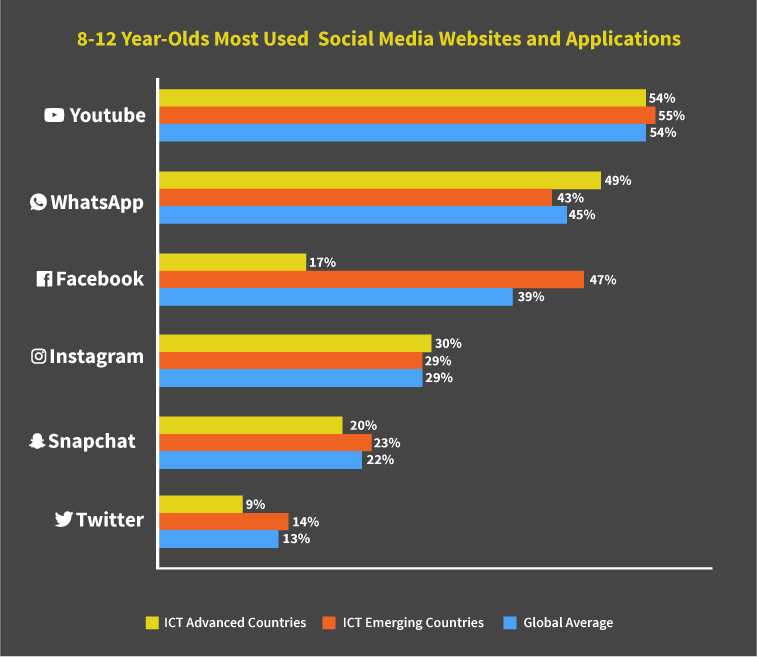 |
|
| This Study suggests that the first online experience for many young children is participation on these social media platforms. There is an increasing trend for young children to use YouTube as their preferred search site over text-based search engines such as Google as they are more accustomed to video-based information.
We are beginning to understand the role that algorithms play in incentivising children to spend more time on social media platforms10 as advertisers profit from children’s short attention span and their tendency to watch similar videos repeatedly. Platforms that grow by monetising attention and increasing user traffic may inadvertently cause children to spend more time on their devices. Moreover, without adequate content rating or effective filtering mechanisms, children are easily exposed to violent and inappropriate contents through social media sites. |
|
|
4. 12 More Hours of Screen Time per week & 70% Likelihood of Cyber-Risks for Young Phone Owners Who Actively Participate in Social Media
When children have their own mobile phones and easy access to internet, it is natural for them to more actively use digital media in general and start highly actively participating (i.e., making and posting videos and photos, creating online profiles, and buying and selling physical and virtual items) in social media. 91% of young mobile phone owners use various social media sites and apps, compared to 70% of children who do not own mobile phones. Moreover, 54% of young phone owners become active social media participants, while only 28% of children without phones become active participants. When young mobile owners actively participate in social media, their screen time is acutely high as they spend an average of 39 hours per week online, which is 12 more hours per week compared to the average screen time of children who do not own mobile phones. Moreover, 70% of children who own mobile phones and are actively involved in social media engage in cyber-risks which is a 20% higher likelihood compared to those who do not own mobile phones. |
|
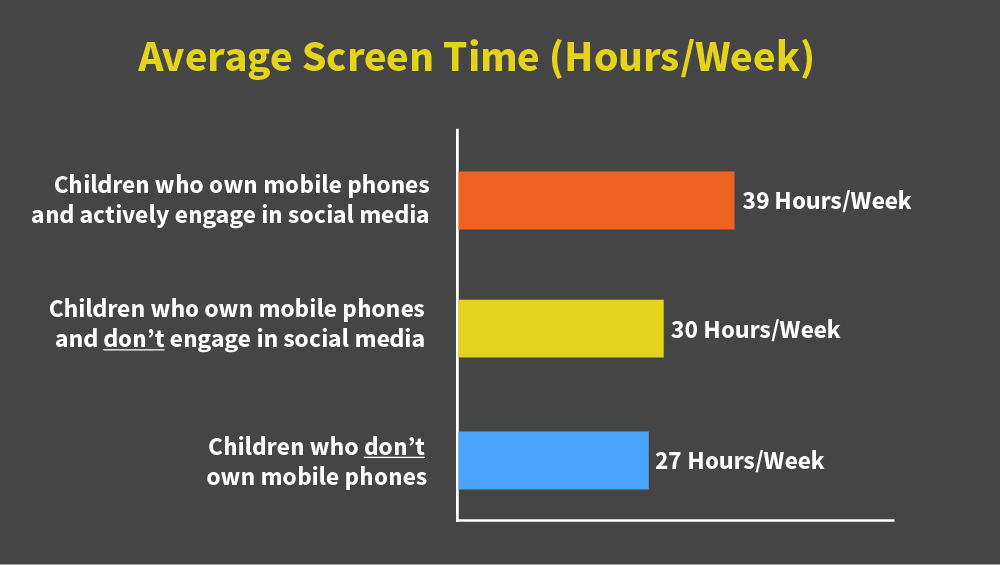 |
|
 |
|
 |
“The majority of urban children in Nepal don’t want to eat and do homework without playing games in mobile phones and watching videos on YouTube. Children are addicted to these devices. They are using them as part of their daily life. Social media-related crimes are growing and include using porn contents in social media or creating fake profiles to intentionally harm someone. Local newspaper published about 830 complaints related to cyber-crimes last year. Most of the cases took place through social networking sites such as Facebook, Twitter, and Instagram.” – Mr Kedar Kilanbu, Adviser to APEX ICT Institute and DQ Ambassador to Nepal |
| Considering the developmental needs of 8-12 year olds, it is important to recognise that they fit into their peer groups while they still have a limited capacity for self-regulation 11, 12. During this time, they seek out greater independence from parents and start to look for new people and information sources that they can relate to or idolise. Thus, they become highly susceptible to media and peer pressure that can potentially lead to various cyber-risks, especially cyberbullying and video game addiction.
Clearly, this high-risk pair of mobile phone ownership and highly active use of social media at an early age calls for urgent needs to equip children with digital skills to safely navigate the digital world with critical thinking. |
|
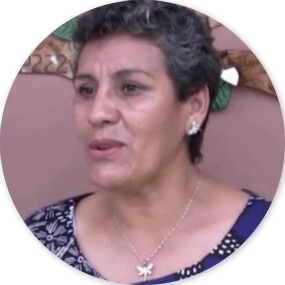 |
“I hear the students boast that they have a Facebook account and have hundreds of contacts, when of those hundreds of contacts they probably only know 10 people. Even first-year children bring a mobile phone and, although the regulation states that they should not bring a mobile phone, nevertheless our society goes through a very convulsive time in terms of violence and a mobile phone becomes a necessary tool for parents to be in contact with their children. Having access to this type of technology, and normally all mobile phones already have access to all the applications they want, then they become even more vulnerable due to the lack of knowledge about proper management of them.” – Profra. Leticia Maldonando Ortiz, Director of Congreso de Anahuac Primary School, Guerrero, Mexico |
Negative Impacts
How do excessive screen time and undisciplined social media use impact
children’s behaviours, mental health, and development?
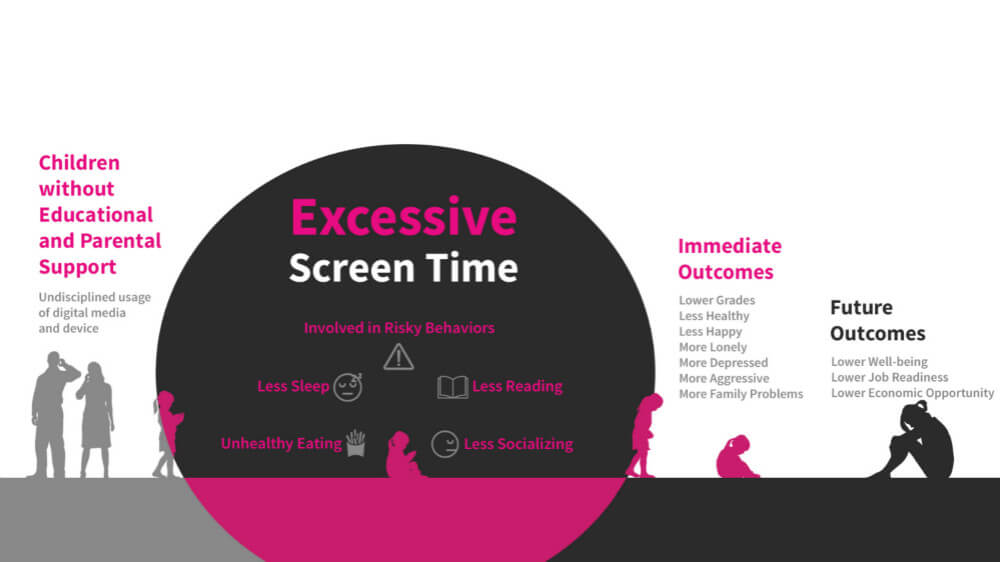 |
|
|
1. Behavioural Changes: Less Sleep, Less Reading, and Less Socialising Many studies have shown that there are many possible side effects from excessive screen time. People experience a decline in both quality and quantity of sleep when they become dependent on their devices13. Similar results have been found among adolescents where social media use at night resulted in poorer quality sleep14. In particular, when children have access to technology such as a TV or mobile phone in the bedroom, important activities like reading and sleeping are displaced due to the tendency for children to overuse such technologies15. More than three hours per day of screen time also inhibits social skills development in children. When teenagers did not use digital technologies for a few days, they were much better at identifying the emotions of strangers16. However, we are seeing an increasing trend of replacing face-to-face interactions with computer-mediated communication. 2. Mental Changes: Lonelier, More Depressed and More Aggressive. When children have poor sleep, it affects their physical and mental health. A child’s bad sleep is associated with lower self-esteem, as well as increased levels of depression and anxiety14. Researchers have found that people who use greater amounts of social media experienced less social bridging and bonding, and thus developing less social capital18. It has also been found that when children use more social media, they experience greater loneliness. When children try to seek out peer approval online through image-hosting social media sites, they are more likely to report superficial friendships, damaging their capacity to form strong bonds with their friends17. In addition, having more friends on Facebook could predict clinically relevant symptoms of narcissism, and histrionic personality disorder19. The situation gets worse when children are exposed to cyberbullying or other cyber-risks. There is a significant association between cyberbullying, being bullied and depression and suicide20. Victims of bullying are especially prone to become depressed, and in many cases, developing suicidal thoughts. Studies have found that victims of cyberbullying are 120% more likely to engage in suicidal ideation and 160% more likely to attempt suicide21. Moreover, there is also an overall increase in aggression and aggressive tendencies from playing violent video games and immersion violent media regardless of age22. 3. Results: Lower Grades, Less Healthy, Less Happy These changes all lead to children being less happy, less healthy, and having lower grades. Many studies support that excessive screen time is associated with less reading and lower academic achievement13, 19. Moreover, excessive social networking is associated with a poorer school experience overall, stemming from poor sleep habits and related factors23. Studies have shown that when students engage more in mobile social media on their mobile phone, they tend to have lower GPA24. There are also health effects from excessive screen time: greater total media use is associated with poor mental and physical health as well as poor interpersonal relationships, and low happiness25. This is especially prevalent for preteens who are actively engaged in video games and social media26. In fact, for teenagers, almost every type of technology use predicts psychological issues, behaviour concerns, attention problems, and physical health problems26: this is extended to overall mental health with adolescents, who use more than 2 hours of social networking websites per day reporting that they have worse mental health, including higher levels of distress and suicidal thoughts20, 21. |
The Strategy
| Digital Intelligence
How can we empower children to convert
It is time for us to reverse the tide. Disconnecting children from the digital world due to fear of cyber-risks is not an option. Being able to access the digital world is one of the basic rights of children in the 21st century. It is equally important for us to anticipate the greater upside of technology in children’s lives. Education is the answer. Our children need to be equipped with the right skills for them to be resilient to cyber-risks and to maximise their opportunities in the digital world. There is no doubt that technology can create great benefits for children in numerous areas ranging from education and future job potential to entertainment. For example, a recent UNICEF report entitled ‘Children in a Digital World’ illustrates the potential benefits of technology to empower children in remote areas and refugees camps by encouraging collaboration, information sharing, and new social connectivity3. It also highlighted how children can develop job-related skills when they learn to read, write, and participate online. Technology can furthermore foster entrepreneurial thinking, helping children develop citizenship norms when they engage in social activism through digital platforms. As such, children need to have Digital Intelligence27 which is a comprehensive set of all digital skills that children need to thrive in their digital futures.
It is important to note that the first step of digital intelligence is digital citizenship28. Digital citizenship is a set of capabilities to use digital media and technologies ethically, safely and responsibly. All benefits from the digital world can be unlocked only when children are equipped with the comprehensive set of digital citizenship skills so that they can avoid cyber-risks with critical reasoning first. Moreover, they also need to be able to evaluate and choose good digital services/products as conscious consumers and to become good users and creators of technology. Specifically, comprehensive digital citizenship education should teach children about how to:
|
|
 |
“We believe that digital citizenship is everyone’s responsibility. In Thailand, many children do not know how to protect their identity. They do not know what information they should or should not share with the people they meet online. Furthermore, many children tend to believe fake news or information that people pass on without thinking or analyzing. I think that these are the issues that need to be addressed.” – Dr. Meechai Orsuwan, an Education Policy Analyst, United Nations. |
| With the understanding of the cyber-risk pandemic facing children, especially 8-12 year olds, nations should consider implementing digital citizenship education as part of the national curriculum for primary schools as a first-rate priority. | |
Ethical
Digital
Ecosystem
Our Collective Responsibility
 |
“In 2015, a local foundation in the Philippines conducted a survey among 7-16 year old children. That survey revealed that almost 80% of them experienced cyberbullying. What is more alarming about that survey is that almost less than half of them said that they are not comfortable sharing this bad experience with their parents. Parents, teachers, and caregivers should create a safe environment for children to know that they will be helped and assisted in facing this challenge.” – Ms Kristelle Ortiz, Learning Designer of Woo hoo Learning Lab, Philippines |
| Empowering children with digital intelligence is only the start. Building a safe support network for children is crucial – from caring parents and capable teachers to supportive communities. At a national level, all stakeholders in the digital ecosystem should put their efforts together to develop an “ethical digital ecosystem”, where every child is safely and securely protected, every child has their Rights of the Child respected, and every child has equal opportunities to thrive in their digital future.
To achieve this goal, all aspects of the digital lives of children – from internet access points, networks, family digital culture, school education, ICT business practices, civic sector supports and government policies in the digital ecosystem – should have proper principles and tools in place to ensure the safe, responsible, and ethical use of technology. |
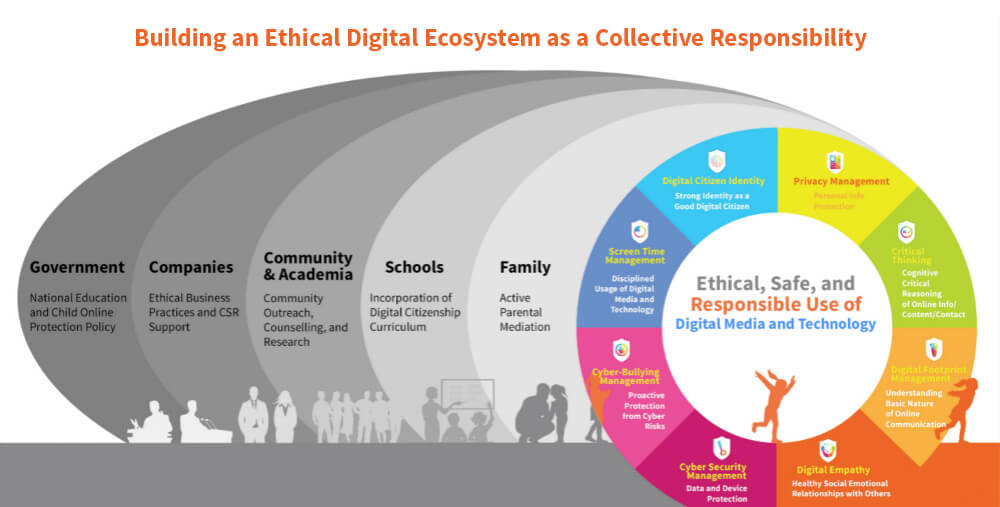 |
DQ as a Vaccine
– Dr. Meechai Orsuwan, Education Policy Analyst, United Nations.
#DQEveryChild is a strategic global movement to empower 8-12 year olds to become good digital citizens. It works like a vaccine against cyber-risks by empowering children with comprehensive digital citizenship skills from the beginning of their digital lives. The usual bottlenecks for nations to implement digital citizenship education programmes at the national level are:
In order to overcome these issues, the #DQEveryChild movement provides nations with a tested and proven, research-based online platform: DQ World29. This online platform enables 8-12 year olds to self-learn comprehensive digital citizenship skills and receive real-time feedback and assessment with minimal support needed from teachers and parents. It can be used by any child, any parent, and any teacher, with the same quality and consistency. It supports nations in implementing high-quality digital citizenship education in their public primary education systems through a simple, fast one-stop ‘plug & play’ solution. Moreover, it is designed to build a healthy and secure support network by connecting all stakeholders using a public health approach. |
|
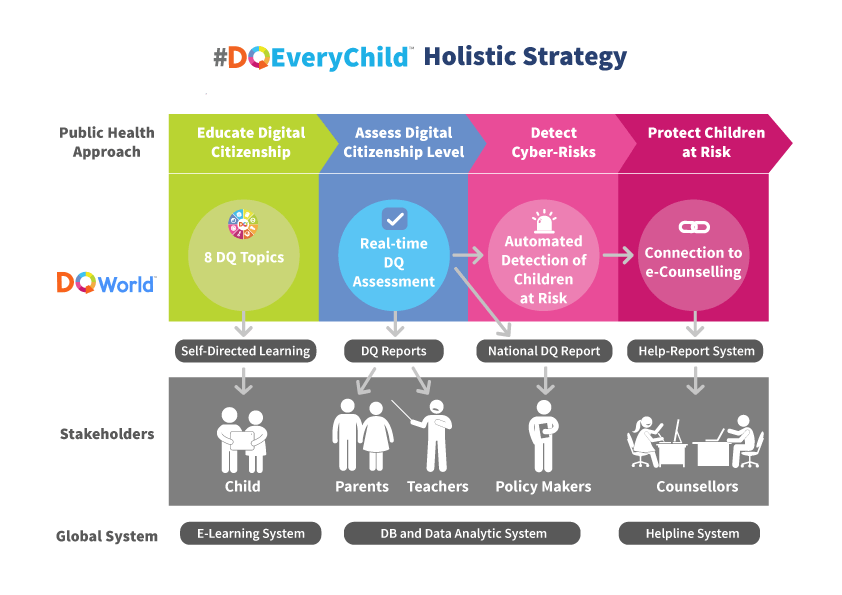 |
|
|
The Impact
| Educational Benefits
The DQ programme31 has had a significant and positive impact on children’s development across several important areas:
1. Safe and responsible attitudes and behaviours online 2. Balanced screen time and self-control 3. Better understanding of online presence, privacy and data protection 4. Enhanced media and information literacies 5. Higher empathy and global citizenship 6. Active parental mediation and school intervention 7. Increased social, emotional and physical well-being 8. Better academic performance and future opportunity The Study found that children globally who complete DQ World see a 10% increase in their DQ score, corresponding to a 15% reduction in cyber-risks. For example, with an average score of 100, the likelihood of a child becoming exposed to cyber-risks is 56%. However, by increasing their DQ score to 110, this likelihood drops to 40%. Raising their score to 120 further reduces it to 28%, and raising the score to 130 reduces it further down to 18%. |
|
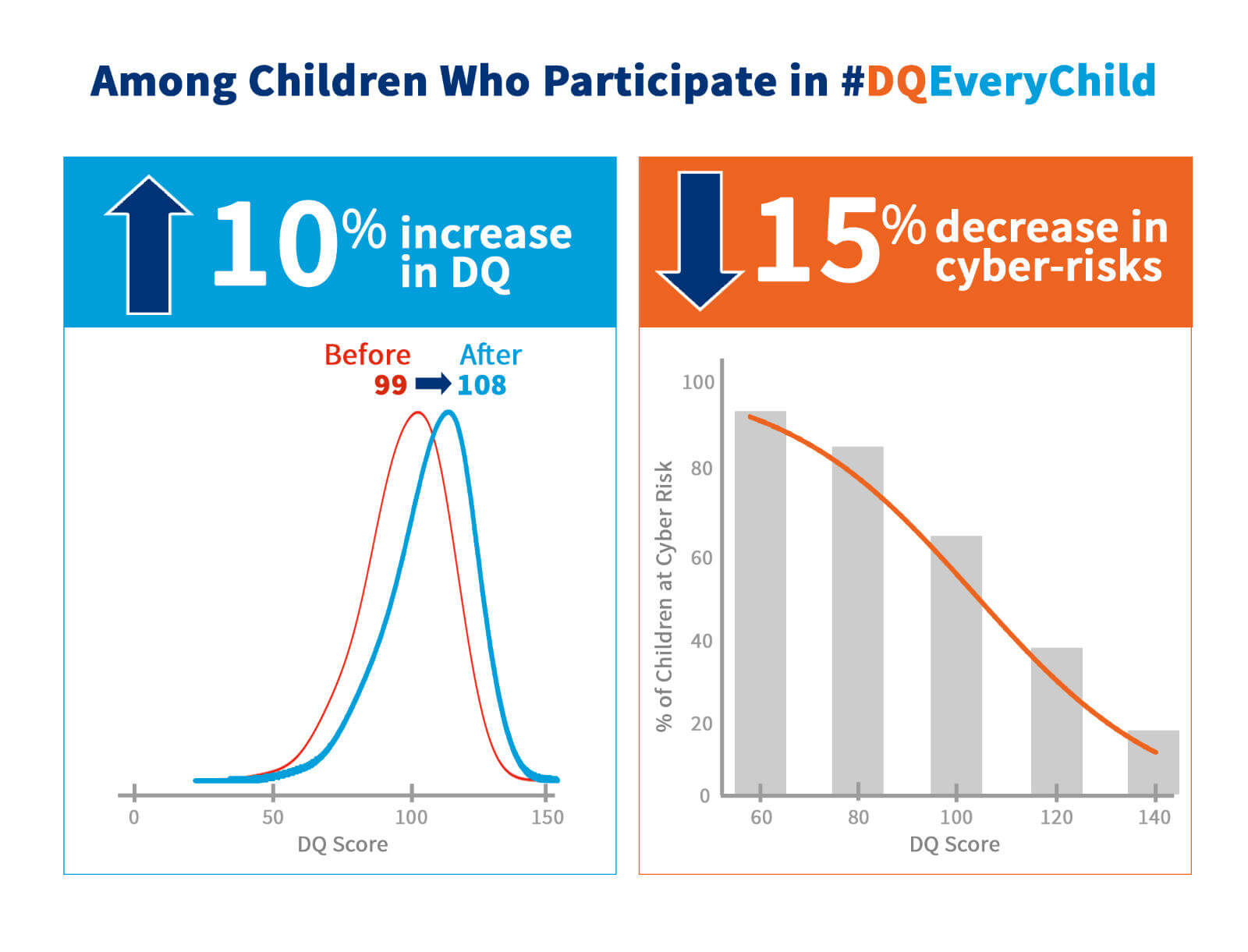 |
Exponential
Expansion
#DQEveryChild has had exponential growth in 2017. It was created as a research-based social initiative developed in Singapore through a multi-stakeholder collaboration including Nanyang Technological University, Singtel, the Singapore government, and infollutionZERO in Korea. It has since transformed into a global movement – run by the DQ Institute – an international coalition formed through the World Economic Forum.
In March 2017, the pilot movement was launched globally. Within 9 months, the coalition expanded to include 100 partner organisations and is now active in more than 30 countries. As a result, it has reached out to 600,000 children around the world as of today.
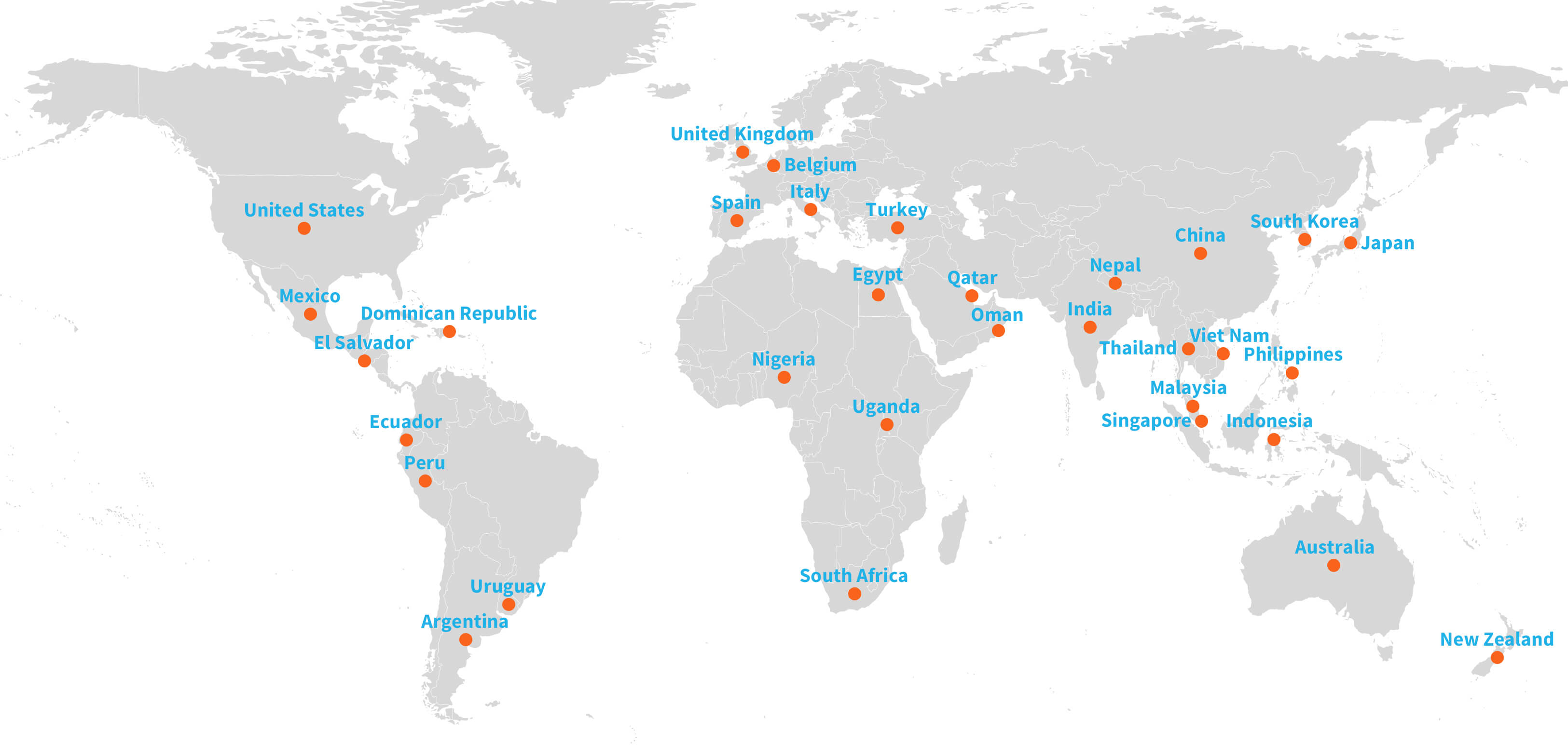 |
| The exponential growth and success of 2017 has encouraged the coalition towards its goal of providing DQ education to more than 100 nations by 2020. |
| In this section, we share 4 case studies that introduce how different nations are utilizing #DQEveryChild for their own benefits, customizing the programme to their own needs and circumstances.
Given each nation’s different stages of ICT development and related social infrastructure, adopting a global movement in their education system in a short period of time is usually difficult to achieve. However, we learned through the 2017 #DQEveryChild movement that a few passionate leaders can bring about swift change. The following case studies show how these leaders created positive changes in their nations, starting from within their communities and expanding the movement to other diverse stakeholders. |
Unique Team of Cross-Sector Stakeholders
Case Study: Singapore
- Background: World’s test bed for smart nations & digital citizenship education
- Outcome: World-leaders in cyber-wellness research and education
- Key Learning: Building a city-level digital ecosystem can be an effective strategy
Having coined the term “cyber wellness” and having developed an instituted cyber-wellness curriculum for primary schools (equivalent to 4 hours per semester), the Singaporean Ministry of Education (MOE) is among the world’s leaders in digital citizenship education. However, these teaching requirements presented a challenge to teachers, as many did not have deep knowledge about digital citizenship. Likewise, heavy schedules limited their ability to find suitable resources and tools. For these reasons, the Inter-Ministry Cyber Wellness Steering Committee (ICSC), including the MOE and the Info-communications Media Development Authority (iMDA), supported the development and outreach efforts of #DQEveryChild in providing educational materials for primary school cyber wellness and character education.
More importantly, Singapore has developed a unique model of public-private-academic-civic partnerships in promoting digital citizenship by taking advantage of being a small, smart city nation with high efficiency.
|
One of our partners Carol Loi delivered a assembly talk in Chongzheng Primary School in Singapore |
 |
“The partnerships between governments, private organisations and community partners will enable scale and consistency in reach and intervention.” -Andrew Buay, Vice President, Singtel Group Corporate Social Responsibility, Singapore |
For instance, in addition to normal school programmes, a short 4-day summer camp programme was carried out by Singtel employee volunteers for low-income families at the Singapore Indian Development Association (SINDA). Through the 4-day workshop, participating children completed the programme with high DQ improvement. |
|
The Singapore model demonstrates that building a city-level digital ecosystem through a strong cross-sector collaboration is an effective strategy that can serve as a benchmark for other nations.
Large-Scale Government Driven Initiative
Case Study: Mexico
- Background: Digital education reformation in the midst of national digital transformation
- Outcome: National DQ Report with a goal of understanding children’s digital citizenship and online safety levels compared to global averages
- Key Learning: Federal government level support can scale up impact
In September 2017, a strong leadership group spearheaded by MarÃa Cristina Cárdenas Peralta, General Coordinator of @prende.mx, Ministry of Public Education championed the initiative to conduct the largest-ever national DQ pilot in public schools. She believed that #DQEveryChild should be introduced as part of a government-driven education reform of the digital economy. The Mexican government started implementing national digital education reform by strategically engaging international players to bring international best-case practices to equip children with digital skills.
|
Children from a primary school in Guerrero, Mexico, learn about screen time management, as part of the Mexican Ministry of Public Education’s nationwide 2017 DQ World Pilot |
  |
“How excited we are to have the first diagnostic of where we are in digital citizenship to continue working and to encourage teachers to be prepared for the future and to use the Internet safely.” – MarÃa Cristina Cárdenas Peralta, General Coordinator of @prende.mx, Ministry of Public Education, Mexico |
| She and her team worked closely with the DQ Institute in order to localise Spanish-language educational contents for schools in Mexico. They persuaded the State Ministers of Education and educators one-by-one to become part of the national pilot roll-out. As a result, the DQ World programme was introduced across 13 different states within 3 months. |
| The government is collaborating with the DQ Institute to develop a national adoption plan for 2018 based on the 2017 Mexico national report, with insights obtained through measuring state-specific levels of digital citizenship and online safety among primary school students.
In addition to the Mexican MOE’s support, A Favor de lo Mejor, a non-profit with the mission to promote media literacy and digital citizenship, chose to roll out the DQ pilot programme in Mexico in order to understand their students better before rolling a DQ World pilot. Sr. Francisco Javier González Garza, President of A Favor de lo Mejor, believed the #DQEveryChild movement aligns with his concerns about the impact of media on Mexican society. |
 |
“We are concerned about the impact of media in our society. That is why we look forward to filling screens with stories of values. We want to boost ideas with conscience and social responsibility”
– Lic. Francisco Javier González Garza, President, A Favor de lo Mejor, Mexico |
| Together with Educational Project Manager, EstÃbaliz De la Torre, the AFM team swiftly reached out to their network of private schools. As a result, thousands of more young students have participated in the programme.
The success story of Mexico further showcases that DQ can be easily implemented in the public education system in a short amount of time, with strongly driven governments and passionate social organisations recognising this urgent need. |
Passionate
Civic Leaders.
Revolutionary
Change.
Case Study: Nepal and Nigeria
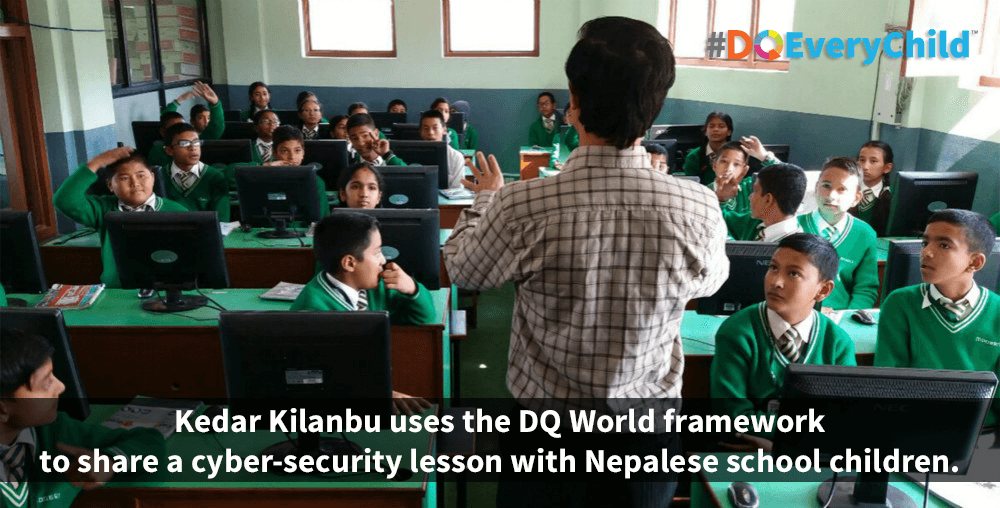
“My country needs to raise Digital Intelligence to empower the current generation of children to become digital leaders in order to reduce gaps in future generations.”
– Mr. Kedar Kilanbu
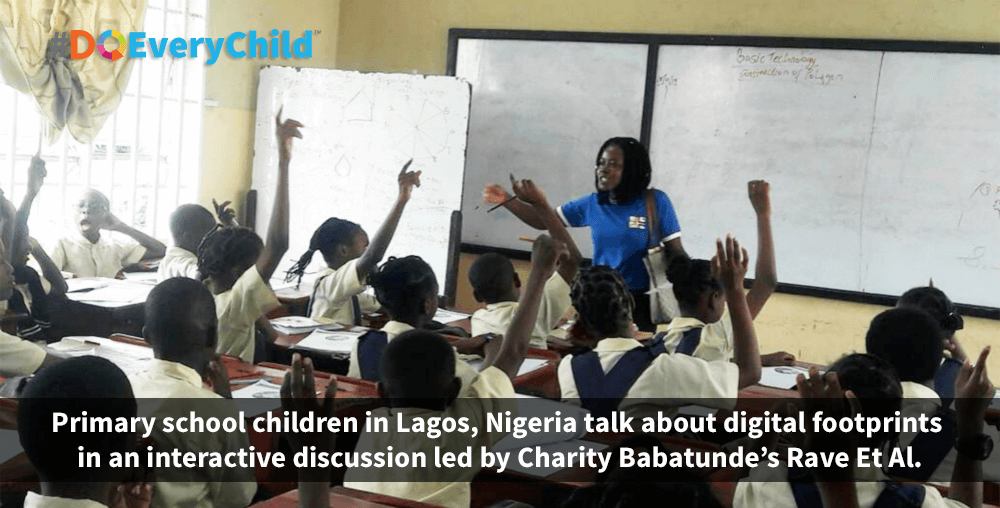
Half a world away, in Nigeria, a former investment banker is now one of the most enthusiastic ambassadors of DQ. Recognising the importance of good citizenship skills both offline and online, Charity Babatunde believes in using DQ to raise responsible digital citizens and tackle cyber-crime in her country. Recognising the growing problem, Charity set up Rave Et Al Limited, an organisation dedicated to promoting digital citizenship and brought a DQ revolution to Nigeria.
 |
“…Not many places have access to the Internet. But I think the first thing is embracing the idea. Being a digital citizen starts out from you being a good citizen. Â The values that we are taught in digital citizenship start from being a good Nigerian citizen. Â Good means that you are honest, empathetic towards people, being responsible and respectful. Â Once we start on that, we can work on our issues. Â Our issues will not change overnight, such as having access to the Internet or access to the digital world! But we will begin to put pressure in the right places.”
– Ms Charity Babatunde, Founder, Rave Et Al Limited, Nigeria |
|
Charity and her team proceeded to apply the DQ educational framework to structure a variety of local initiatives, including educator workshops to promote proactive parenting and to empower children with digital skills and values. With her dedication, her organisation reached over 1,000 children over the course of three months. In the future, Charity hopes to expand her initiative towards parents as well, helping parents bridge the digital gap with their children to embody citizenship values that will help Nigeria thrive. |
Fast Implementation
by ICT Companies
Case Study: Turkey, Thailand, and the Philippines
- Background: Recognising the need for CSR Intervention from ICT companies
- Outcome: Multi-stakeholders involved to aid national adoption
- Key Learning: Impact measurement achieves multi-stakeholder collaboration
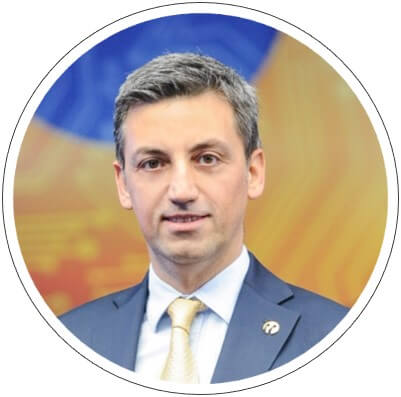 |
“As adults, I ask myself: are we fully equipped and fully prepared for this new world – this digital new world? And of course not only adults, but also the kids, our children – are they fully prepared for this new world? […] I see a lot of value where DQ can make a positive impact in society together with Turkcell.” – Ä°smail Bütün, Chief Marketing Officer of Turkcell |
ICT companies are stakeholders that can most effectively bring the movement to their countries through corporate social responsibility (CSR) efforts. Many ICT companies have designated resources to support their communities and wide school networks based on their existing education activities. They are also in a good position to bring local NGO and government partners to the table and to scale up initiatives to the national level when pilots show efficacy.
We have witnessed how a major ICT company can systematically bring the programme to nations together with cross-sector partners. Turkey, Thailand and the Philippines are prime examples. Even though these three countries have very different national characteristics and needs, the process they are taking to bring the movement to their children is similar: 1) translate the educational content into local languages; 2) run a pilot through their existing school networks; and 3) expand through local NGO, academic, government partner collaboration.
For instance, in Turkey, Turkcell rolled out a pilot run together with Professor Mustafa Hilmi Çolakuglu and started implementation with a focus on 11-12 year old students who have a mandatory computer tech class and for whom the programme could easily be integrated. The Ministry of National Education also implemented the programme directly to schools. Over 1,700 educators responded – the largest national level of teacher participation of the study.
In Thailand, two educators, Dr Meechai Orsuwan of the United Nations in Bangkok and Dr Veerapong Malai of Bangkok University took it upon themselves to assess the need for DQ in their country, reaching out to 4,000 students over a period of just 2 months. They found the need for digital citizenship education while working on their government-supported research on flipped classrooms and 21st-century skills for students.
On the public sector’s side, The Digital Economy Promotion Agency, under the Ministry of Digital for Economy and Society, together with the Office of the Basic Education Commission, Ministry of Education and EduTech Thailand also supported Study participation in Thailand. Believing that the Study provides very important insights, they will use the results to form an improved digital development strategy for Thai children. “The ways children use and interact with digital media are totally different from adults. The digital age gap makes it difficult for parents and educators to fully understand them, and to give practical advice. In a world where children are ‘growing up digital,’ it’s important to help them learn healthy concepts of digital use and citizenship.” – Dr. Nuttapon Nimmanphatcharin, President/CEO, Digital Economy Promotion Agency, Ministry of Digital Economy and Society, Royal Thai Government.
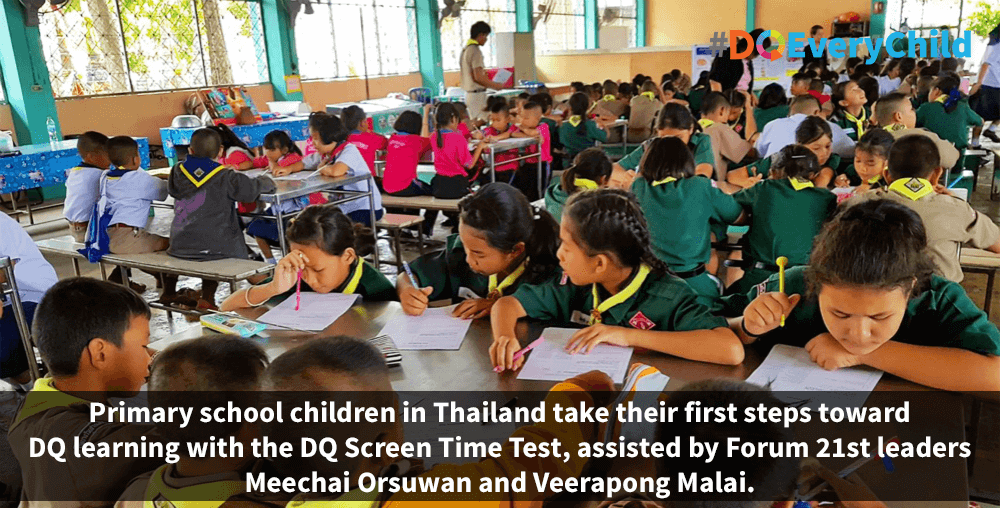
 |
“When the future is unpredictable, we shall create the future by shaping opportunities. Digital citizenship is everyone’s responsibility. It is pivotal that we create safe and effective space for our students to actively do it! We need to help every child live with new media. We need to teach young people to safely learn, play, socialise, and participate in the digital world. Â We are glad to be working with DQ Institute to create a happy digital world!” – Dr. Veerapong Malai, Bangkok University, Thailand |
|
In the Philippines, a four-pronged approach has been formulated through the work of a telecommunications company, Globe Telecom; two NGOs, ASSIST Asia and Junior Achievement Philippines; and an educational technology company, Woohoo Learning Lab. These organisations reached out to each of their respective networks to roll-out a pilot #DQEveryChild in across the Philippines, and national results will be presented to the Department of Education for next year’s national roll-out. |
||||||||
 |
“Globe Telecom is supporting the DQ Institute to determine the Digital Intelligence Quotient of the Philippines through the multinational DQ Study. This enables us to create new learning techniques to elevate the learning experience of children in the Philippines.” -Yoly Cristanto, Globe Senior Vice President for Corporate Communications, Globe Telecom, Philippines |
About
AcknowledgementsThe 2018 DQ Impact Report is an annual report summarizing the state of online safety and digital citizenship of 8-12 year olds around the world and reviewing the impact of #DQEveryChild in improving digital citizenship among children. The 2017 DQ Impact Study was conducted as part of the #DQEveryChild initiative and included 37,967 8-12 year old study participants across 29 countries. The Study is one of the first large-scale, multi-national projects investigating online behaviours, exposure to cyber-risks, and digital citizenship levels among 8-12 year old children. DQ Team and Advisers
MethodologyParticipants We collected data from 29 countries including Argentina, Australia, China, Dominican Republic, Ecuador, Egypt, India, Indonesia, Italy, Japan, South Korea, Malaysia, Mexico, Nepal, New Zealand, Nigeria, Oman, Peru, Philippines, Qatar, Singapore, South Africa, Spain, Thailand, Turkey, United Kingdom, United States, Uruguay, and Vietnam. 50% of the participants were female and the ages of the participants ranged from 8-12 years. 26% of participants were 12 year olds, 30% were 11 year olds, 25% were 10 year olds, and 19% were 9 and 8 year olds. The children participated through their schools, either in the classroom or at home on the website where the survey was hosted. Participants were recruited by the students’ teachers and administrators. There was no incentive offered for participation.
|
|
| Materials
The data was collected through two different mediums, the online platform DQWorld.net and the DQ student survey. The DQ student survey was a shortened form of the one used on DQWorld.net in order to be able to assess similar risks in less time. All questions in the student survey are available on DQWorld.net. The survey was created to assess risk across multiple areas, including gaming addiction, cyberbullying, online sexual content, and meeting online strangers. The DQ Student survey consisted of 81 questions which were taken from the larger DQWorld.net questionnaire of 295 questions. The data was collected from March 2017 to November 2017 across both platforms. The student survey was distributed to students by their teachers to either fill out in class or at home later. In some countries, pen and paper surveys were given out, with results coded and sent by teachers. Procedures Students were recruited through the aid of teachers and school administrators who were contacted by partners located in each country. The amount of time required to fill out each of the DQ student surveys is around 60 minutes and the amount of time to complete the activities on DQWorld.net is around 10 hours. In the beginning, students were told that we would be assessing their Digital Intelligence and that they would receive a score to see how they compared to their school and country average. Survey questions were then matched with those from DQWorld.net to allow us to combine the data. Limitations There are some limitations of this Study. As the Study was conducted as part of the #DQEveryChild initiative, the participants were selected at convenience and the number of participants from each country varied depending on the extent of the initiative’s adoption in that country. Thus, while the results are statistically significant, there are limitations in claiming that results obtained in each country are fully representative of that country. |
Reference1. Benoit, D (2018, Jan 07) iPhones and Children Are a Toxic Pair, Say Two Big Apple Investors. Retrieved from: link 2. Willsher, K. (2017, Dec 11) France to ban mobile phones in schools from September. link 3. The State of the World’s Children 2017. (2017, December 11). Retrieved January 17, 2018, from link 4. FACT SHEET: A summary of the rights under the Convention on the Rights of the Child Retrieved January 17, 2018, from link 5. “Statistics.” ITU, link 6. “Gross Domestic Product 2016.” World Bank, link 7. American Academy of Pediatrics Announces New Recommendations for Children’s Media Use. Retrieved January 17, 2018, from link 8. Swing, E. L., Gentile, D. A., Anderson, C. A., & Walsh, D. A. (2010). Television and video game exposure and the development of attention problems. Pediatrics, 126(2), 214-221. 9. Russo, M., Bergami, M., and Morandin, G.,. (n.d.). Surviving a Day Without Smartphones. Retrieved January 17, 2018, from link 10. LaFrance, A. (2017, July 25). The Algorithm That Makes Preschoolers Obsessed With YouTube. Retrieved January 17, 2018, from link 11. Child Development. (2016, March 15). Retrieved January 17, 2018, from link 12. Mah, V. K., & Ford-Jones, E. L. (2012). Spotlight on middle childhood: Rejuvenating the ‘forgotten years’. Paediatrics & child health, 17(2), 81-83. 13. Rosen, L., Carrier, L. M., Miller, A., Rokkum, J., & Ruiz, A. (2016). Sleeping with technology: cognitive, affective, and technology usage predictors of sleep problems among college students. Sleep Health: Journal of the National Sleep Foundation, 2(1), 49-56. 14. Woods, H. C., & Scott, H. (2016). # Sleepyteens: social media use in adolescence is associated with poor sleep quality, anxiety, depression and low self-esteem. Journal of adolescence, 51, 41-49. 15. Gentile, D. A., Berch, O. N., Choo, H., Khoo, A., & Walsh, D. A. (2017). Bedroom media: One risk factor for development. Developmental psychology, 53(12), 2340. 16. Ali, S. (2016). Relationship Between Technology Use and Development of Social Skills (Doctoral dissertation, California State University, Northridge). 17. Bergman, S. M., Fearrington, M. E., Davenport, S. W., & Bergman, J. Z. (2011). Millennials, narcissism, and social networking: What narcissists do on social networking sites and why. Personality and Individual Differences, 50(5), 706-711 18. Burke, M., Marlow, C., & Lento, T. (2010, April). Social network activity and social well-being. In Proceedings of the SIGCHI conference on human factors in computing systems (pp. 1909-1912). ACM. 19. Rosen, L. D., Whaling, K., Rab, S., Carrier, L. M., & Cheever, N. A. (2013). Is Facebook creating “iDisorders”? The link between clinical symptoms of psychiatric disorders and technology use, attitudes and anxiety. Computers in Human Behavior, 29(3), 1243-1254. 20. Van Geel, M., Vedder, P., & Tanilon, J. (2014). Relationship between peer victimization, Cyber-bullying, and suicide in children and adolescents: a meta-analysis. JAMA pediatrics, 168(5), 435-442. 21. Gámez-Guadix, M., Orue, I., Smith, P. K., & Calvete, E. (2013). Longitudinal and reciprocal relations of Cyber-bullying with depression, substance use, and problematic Internet use among adolescents. Journal of Adolescent Health, 53(4), 446-452. 22. Bushman, B. J., Gollwitzer, M., & Cruz, C. (2015). There is broad consensus: Media researchers agree that violent media increase aggression in children, and pediatricians and parents concur. Psychology of Popular Media Culture, 4(3), 200-214. 23. Vernon, L., Barber, B. L., & Modecki, K. L. (2015). Adolescent problematic social networking and school experiences: the mediating effects of sleep disruptions and sleep quality. Cyberpsychology, Behavior, and Social Networking, 18(7), 386-392. 24. Al-Menayes, J. (2014). The relationship between mobile social media use and academic performance in university students. New Media and Mass Communication, 25, 23-29. 25. Sampasa-Kanyinga, H., & Lewis, R. F. (2015). Frequent use of social networking sites is associated with poor psychological functioning among children and adolescents. Cyberpsychology, Behavior, and Social Networking, 18(7), 380-385. 26. Rosen, L. D., Lim, A. F., Felt, J., Carrier, L. M., Cheever, N. A., Lara-Ruiz, J. M., … & Rokkum, J. (2014). Media and technology use predicts ill-being among children, preteens and teenagers independent of the negative health impacts of exercise and eating habits. Computers in human behavior, 35, 364-375. 27. Park, Y. (2016, June). 8 digital skills we must teach our children. Retrieved January 17, 2018, from link 28. Park, Y. (2016, September). 8 digital life skills all children need – and a plan for teaching them. Retrieved January 17, 2018, from link 29. Empower Children with 8 Digital Citizenship Skills in 5 Days! (2017, September). link 30. Singapore and Australia First to Launch DQ Institute Cyber-risk Reporting System for Children. (2017, September) Retrieved January 17, 2018, from link 31. DQImpact (Part 2). Retrieved January 17, 2018, from link |



